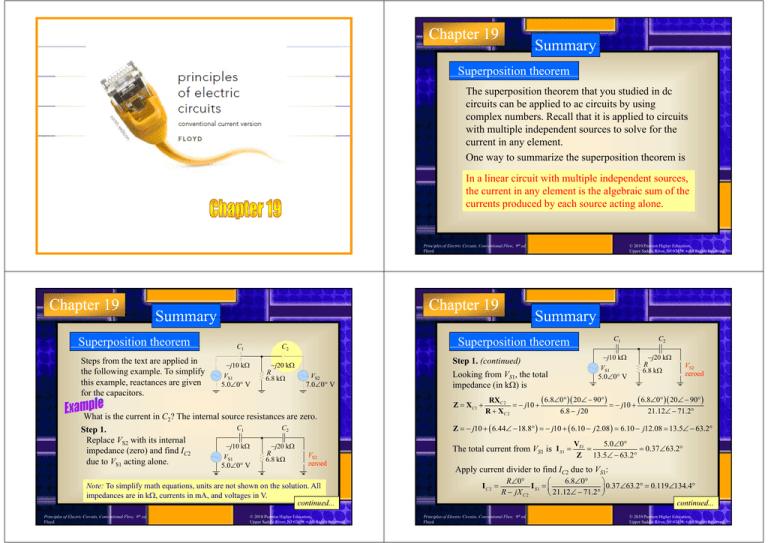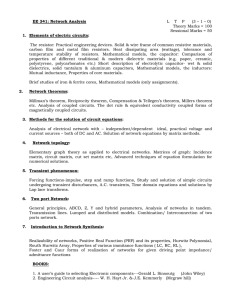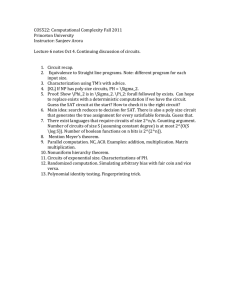
Chapter 19
Chapter 19
Summary
Superposition
p p
theorem
The superposition theorem that you studied in dc
circuits can be applied to ac circuits by using
complex numbers. Recall that it is applied to circuits
with multiple independent sources to solve for the
current in any element.
One way to summarize the superposition theorem is
In a linear circuit with multiple independent sources,
the current in any
y element is the algebraic
g
sum of the
currents produced by each source acting alone.
Principles of Electric Circuits, Conventional Flow, 9th ed.
Floyd
Chapter 19
© 2010 Pearson Higher Education,
Upper Saddle River, NJ 07458. • All Rights Reserved
Chapter 19
Summary
Superposition
p p
theorem
Steps from the text are applied in
the following example. To simplify
this example, reactances are given
for the capacitors.
Principles of Electric Circuits, Conventional Flow, 9th ed.
Floyd
C1
5.0∠0° V
−j20 kΩ
R
6 8 kΩ
6.8
Step 1. (continued)
VS2
7.0∠0° V
Looking from VS1, the total
impedance (in kΩ) is
Z = XC1 +
What is the current in C2? The internal source resistances are zero.
Step 1.
Replace VS2 with its internal
impedance (zero) and find IC2
due to VS1 acting
g alone.
C1
−j10 kΩ
VS1
C2
5 0∠0° V
5.0
−j20 kΩ
R
6.8 kΩ
VS2
zeroed
e oed
Note: To simplify math equations, units are not shown on the solution. All
impedances are in kΩ,
kΩ currents in mA
mA, and voltages in V.
V
continued...
Principles of Electric Circuits, Conventional Flow, 9th ed.
Floyd
Summary
C1
Superposition
p p
theorem
C2
−j10 kΩ
VS1
© 2010 Pearson Higher Education,
Upper Saddle River, NJ 07458. • All Rights Reserved
© 2010 Pearson Higher Education,
Upper Saddle River, NJ 07458. • All Rights Reserved
−j10 kΩ
VS1
5 0∠0° V
5.0
C2
−j20 kΩ
R
6.8 kΩ
VS2
zeroed
RXC 2
( 6.8∠0° )( 20∠ − 90° ) = − j10 + ( 6.8∠0° )( 20∠ − 90° )
= − j10 +
R + XC 2
6.8 − j 20
21.12∠ − 71.2°
Z = − j10 + ( 6.44∠ − 18.8° ) = − j10 + ( 6.10 − j 2.08 ) = 6.10 − j12.08 = 13.5∠ − 63.2°
The total current from VS1 is I S 1 =
VS 1
5.0∠0°
=
= 0.37∠63.2°
Z 13.5∠ − 63.2°
Apply current divider to find IC2 due to VS1:
IC 2 =
R∠0°
6.8∠0°
⎛
⎞
I S1 = ⎜
⎟ 0.37∠63.2° = 0.119∠134.4°
R − jjX C 2
⎝ 21.12∠ − 71.2° ⎠
continued...
Principles of Electric Circuits, Conventional Flow, 9th ed.
Floyd
© 2010 Pearson Higher Education,
Upper Saddle River, NJ 07458. • All Rights Reserved
Chapter 19
Superposition
p p
theorem
C1
−j10 kΩ
Step 2.
Find IC2 due to VS2 by zeroing VS1.
The total impedance (in kΩ) is
Z = XC 2 +
Chapter 19
Summary
VS1
zeroed
C2
−j20 kΩ
R
6.8 kΩ
Superposition
p p
theorem
VS2
7 0∠0° V
7.0
RXC1
( 6.8∠0° )(10∠ − 90° ) = − j 20 + ( 6.8∠0° )(10∠ − 90° )
= − j 20 +
R + XC1
6.8 − j10
12.1∠ − 55.8°
Z = − j 20 + ( 5.62∠ − 34.2° ) = − j 20 + ( 4.65 − j 3.15 ) = 4.65 − j 23.15 = 23.6∠ − 78.6°
The total current from VS2 is I S 2 =
Summary
VS 2
7.0∠0°
=
= 0.297∠78.6°
Z
23.6∠ − 78.6°
Notice that IS2 = IC2 for this source and is opposite to IC2 due to VS1.
C1
C2
Step 3.
−j10 kΩ
−j20 kΩ
Find IC2 due to both sources
R
VS1
VS2
6.8
6
8 kΩ
by combining the results
5.0∠0° V
7.0∠0° V
from steps 1 and 2.
IC2 due to VS1 is 0.119∠134.4° = −0.083 + j 0.085
IC2 due to VS2 is
0.297∠78.6° = 0.059 + j 0.291
Subtract because
IC2 due to both sources is
−0.142 − j 0.206
currents oppose.
I polar
In
l form,
f
the
th total
t t l currentt in
i IC2 is
i 0.250
0 250∠ − 124
124.66° mA
A
The result is in the 3rd quadrant, meaning that the actual direction is
reversed from the assumed positive direction. It is due mainly to VS2.
Problems like this example can be easily solved by Multisim, a popular
computer simulation. The Multisim circuit is shown on the following slide.
continued...
Principles of Electric Circuits, Conventional Flow, 9th ed.
Floyd
© 2010 Pearson Higher Education,
Upper Saddle River, NJ 07458. • All Rights Reserved
Chapter 19
Principles of Electric Circuits, Conventional Flow, 9th ed.
Floyd
Chapter 19
Superposition
p p
theorem
© 2010 Pearson Higher Education,
Upper Saddle River, NJ 07458. • All Rights Reserved
Summary
Thevenin’s theorem
Thevenin’s theorem can be applied to ac circuits. As applied
to ac circuits, Thevenin’s theorem can be stated as:
Anyy two-terminal linear ac circuit can be reduced to an
equivalent circuit that consists of an ac voltage source
in series with an equivalent impedance.
Zth
The Thevenin equivalent circuit is:
Vth
Voltage sources are specified
in Multisim as peak voltages.
Principles of Electric Circuits, Conventional Flow, 9th ed.
Floyd
© 2010 Pearson Higher Education,
Upper Saddle River, NJ 07458. • All Rights Reserved
Principles of Electric Circuits, Conventional Flow, 9th ed.
Floyd
© 2010 Pearson Higher Education,
Upper Saddle River, NJ 07458. • All Rights Reserved
Chapter 19
Chapter 19
Summary
Superposition
p p
theorem
Thevenin’s theorem
Steps for applying the superposition theorem:
1
1.
2.
3.
4.
Leave one of the sources in the circuit,
circuit and replace all others
with their internal impedance. For ideal voltage sources, the
internal impedance is zero. For ideal current sources, the
i t
internal
l impedance
i
d
is
i infinite.
i fi it We
W will
ill call
ll this
thi procedure
d
zeroing the source.
Find the current in the branch of interest produced by the one
remaining source.
Repeat Steps 1 and 2 for each source in turn. When complete,
you will have a number of current values equal
y
q to the number
of sources in the circuit.
Add the individual current values as phasor quantities.
Principles of Electric Circuits, Conventional Flow, 9th ed.
Floyd
Chapter 19
© 2010 Pearson Higher Education,
Upper Saddle River, NJ 07458. • All Rights Reserved
Equivalency means that when the same value of load is
connected to both the original circuit and Thevenin
Thevenin’ss
equivalent circuit, the load voltages and currents are the same
for both.
Zth
ac
circuit
R
Thevenin’s theorem
Principles of Electric Circuits, Conventional Flow, 9th ed.
Floyd
© 2010 Pearson Higher Education,
Upper Saddle River, NJ 07458. • All Rights Reserved
Summary
Thevenin’s equivalent impedance (Zth) is the total impedance
pp
g between two specified
p
terminals in a given
g
circuit
appearing
with all sources replaced by their internal impedances.
With load removed
removed,
R
this
is
the
Thevenin
L
voltage.
ac
circuit
Zth
Principles of Electric Circuits, Conventional Flow, 9th ed.
Floyd
R
Thevenin’s theorem
Thevenin’s equivalent voltage (Vth) is the open-circuit
voltage between two specified terminals in a circuit.
circuit
Vth
Vth
For example, if the same R is connected to both circuits, the
voltage across R will be identical for each circuit.
Chapter 19
Summary
ac
circuit
Summary
With load removed,
RL is the Thevenin
this
voltage.
© 2010 Pearson Higher Education,
Upper Saddle River, NJ 07458. • All Rights Reserved
With sources replaced with
their internal impedance, you
could measure Zth here.
Zth
Replace with
internal resistance
Vth
Principles of Electric Circuits, Conventional Flow, 9th ed.
Floyd
With sources replaced with
their internal impedance, you
could measure Zth here.
© 2010 Pearson Higher Education,
Upper Saddle River, NJ 07458. • All Rights Reserved
Chapter 19
Chapter 19
Summary
Thevenin’s theorem
Norton’s theorem
Steps for applying Thevenin’s theorem:
1
1.
O
Open
the
h two terminals
i l between
b
which
hi h you want to find
fi d
the Thevenin circuit. This is done by removing the
component from which the circuit is to be viewed.
2.
Determine the voltage across the two open terminals.
3.
Determine the impedance viewed from the two open
t
terminals
i l with
ith id
ideall voltage
lt
sources replaced
l d with
ith shorts
h t
and ideal current sources replaced with opens.
4
4.
Connect Vthh and Zthh in series to produce the complete
Thevenin equivalent circuit.
Principles of Electric Circuits, Conventional Flow, 9th ed.
Floyd
Chapter 19
© 2010 Pearson Higher Education,
Upper Saddle River, NJ 07458. • All Rights Reserved
Norton’s theorem is also an equivalent circuit that provides
a way to reduce complicated circuits to a simpler form. As
applied to ac circuits, Norton’s theorem can be stated as:
Anyy two-terminal linear ac circuit can be reduced to an
equivalent circuit that consists of an ac current source
in parallel with an equivalent impedance.
The Norton equivalent circuit is:
Principles of Electric Circuits, Conventional Flow, 9th ed.
Floyd
Norton’s theorem
In
Zn
© 2010 Pearson Higher Education,
Upper Saddle River, NJ 07458. • All Rights Reserved
Chapter 19
Summary
Summary
Norton’s theorem
Norton’s equivalent current (In) is the short-circuit current
(ISL) between two specified terminals in a circuit.
circuit
ac
circuit
In
Summary
Zn
Norton’s equivalent impedance (Zn) is the total impedance
appearing between two specified terminals in a given circuit
with all sources replaced by their internal impedances.
With the load replaced with
RLa short, the current in the
short is Norton’s current.
With the load replaced with
RaL short, the current in the
short is Norton’s current.
ac
circuit
An ideal current
source is
replaced with an
open circuit.
In
Zn
With sources replaced with
their internal impedance, you
could measure Zth here.
With sources replaced with
their internal impedance, you
could measure Zth here.
Notice that Zn = Zth.
Principles of Electric Circuits, Conventional Flow,
Floyd
9th
ed.
© 2010 Pearson Higher Education,
Upper Saddle River, NJ 07458. • All Rights Reserved
Principles of Electric Circuits, Conventional Flow,
Floyd
9th
ed.
© 2010 Pearson Higher Education,
Upper Saddle River, NJ 07458. • All Rights Reserved
Chapter 19
Chapter 19
Summary
Norton’s theorem
Maximum ppower transfer theorem
Steps for applying Norton’s theorem:
1
1.
R l
Replace
the
h load
l d connectedd to the
h two terminals
i l between
b
which the Norton circuit is to be determined with a short.
2.
Determine the current through the short. This is In.
3.
Open the terminals and determine the impedance between
the two open terminals with all sources replaced with their
i t
internal
l impedances.
i
d
This
Thi is
i Zn.
4.
Connect In and Zn in parallel.
Recall that in resistive circuits, maximum power is transferred
from a given source to a load if RL = RS.
Impedance consists of a resistive and reactive part. To
transfer maximum power in reactive circuits, the load resistance
should still match the source resistance but it should cancel the
source reactance by matching the opposite reactance as illustrated.
RRSS± jX
RL RmL jX
Principles of Electric Circuits, Conventional Flow, 9th ed.
Floyd
Chapter 19
Summary
© 2010 Pearson Higher Education,
Upper Saddle River, NJ 07458. • All Rights Reserved
Principles of Electric Circuits, Conventional Flow, 9th ed.
Floyd
© 2010 Pearson Higher Education,
Upper Saddle River, NJ 07458. • All Rights Reserved
Chapter 19
Summary
Maximum ppower transfer theorem
The impedance that cancels the reactive portion of the source
impedance is called the complex conjugate.
conjugate The complex
conjugate of R − jXC is R + jXL. Notice that each is the complex
conjugate of the other.
In effect the reactance portion of the load forms a series
resonant circuit with the reactive portion of the source at the
q
y Thus the matchingg is frequency
q
y dependent.
p
resonant frequency.
RS ± jX
RL m jX
Principles of Electric Circuits, Conventional Flow, 9th ed.
Floyd
© 2010 Pearson Higher Education,
Upper Saddle River, NJ 07458. • All Rights Reserved
Principles of Electric Circuits, Conventional Flow, 9th ed.
Floyd
© 2010 Pearson Higher Education,
Upper Saddle River, NJ 07458. • All Rights Reserved
Chapter 19
Principles of Electric Circuits, Conventional Flow, 9th ed.
Floyd
Chapter 19
© 2010 Pearson Higher Education,
Upper Saddle River, NJ 07458. • All Rights Reserved
Chapter 19
Principles of Electric Circuits, Conventional Flow, 9th ed.
Floyd
Principles of Electric Circuits, Conventional Flow, 9th ed.
Floyd
© 2010 Pearson Higher Education,
Upper Saddle River, NJ 07458. • All Rights Reserved
Chapter 19
© 2010 Pearson Higher Education,
Upper Saddle River, NJ 07458. • All Rights Reserved
Principles of Electric Circuits, Conventional Flow, 9th ed.
Floyd
© 2010 Pearson Higher Education,
Upper Saddle River, NJ 07458. • All Rights Reserved
Chapter 19
Principles of Electric Circuits, Conventional Flow, 9th ed.
Floyd
© 2010 Pearson Higher Education,
Upper Saddle River, NJ 07458. • All Rights Reserved




